The TurboGrafx-16 / PC Engine Shmup Library: Pt 2 (Arcade)

Presented by Marurun, Racketboy, BulletMagnet, and hashiriya1
Following up on Part 1 of our epic guide to the scrolling shoot-em-ups found on the TurboGrafx-16 and PC Engine family of consoles, we now have Part 2 ready to go. This second installment focuses on arcade shmups that were ported over to the consoles. While it may be tempting to gloss over arcade ports, there are both some iconic classics and hidden gems to be found here — many of which are either superior ports or even the only console versions available for the given titles.
As in part 1, this guide will cover all the 2D shooters that can be found in all the variations of the PC Engine/TurboGrafx hardware family. We will make distinctions about which format each game utilizes. It’s also worth noting that if you see “PC Engine†in the format listing without a “Turbo†counterpart, the game was only released in Japan.
And, of course, if you missed it, be sure to check out part 1 of this guide that details all the shmups that were only available on consoles (most of which were exclusives to the TG16/PCE)
Shmups 101 | Beginner Shmups | Defining Shmups | Hidden Gem Shmups
Shmup Libraries: TG16/PC Engine |Â Genesis/Megadrive | PS1 | Saturn | Dreamcast | PS2 | Gamecube |
| Game Boy Advance | Odyssey 2 | Amiga |
R-Type
 1988
1988
Developer: Irem
Publisher: Hudson/NEC/Irem
PC-Engine/TurboGrafx-16/PC-Engine SuperCD
As one of the most defining games in the entire shmup genre, R-Type was one of the arcade cornerstones of the TG16 library. This was helped along by fact that this particular port was the most faithful home version of the game until the Playstation came along. The TurboGrafx–16 port features only some minor loss in graphic detail, and a slightly scrolling playfield to compensate for the difference in resolutions.
R-Type is a legendary shooter, known best for its punishing difficulty and the fact that the very level designs themselves are the most dangerous opponent. Like other shooters there are indeed enemies that shoot at you, but the levels themselves regularly intrude into the playfield, sometimes moving and repositioning, forcing players to contend with the constant risk of collision and being boxed in. Unlike other shooters, R-Type required memorization by means of trial and error. Twitch reflexes alone were simply not enough. You can’t shoot your way through the wall like you can through an enemy. Almost in spite of this, R-Type’s most innovative contributions to the genre are its two main means of helping players against enemies and bosses: a chargeable main shot (yes, there was a time when it wasn’t a standard feature), and most importantly the “Force†pod. Invincible, detachable and deceivingly versatile, proper use of the Force is absolutely integral if one ever hopes to reach the end credits. For more detailed analysis of the original R-Type, we recommend checking out HG101’s guide.
R-Type was an early release and doesn’t demonstrate as much graphical pizazz as some later shooters on the system do, but the arcade version was also, in some ways, graphically plain. It’s a good thing it’s insane fun, because the Turbo also replicates the intensity and pacing of the game quite well.
In Japan Hudson released the game split into 2 Hucards, but the US got the whole game in one TurboChip. Later, in Japan, Irem released the R-Type Complete CD for the Super CD-ROM, which included the entire game on one CD. Additionally, there are plenty of fully narrated cutscenes, although none of them are that great, and some weird CD audio remixes of the music.
Check for R-Type on eBay
Check for R-Type on Amazon
Gradius
 1991
1991
Developer: Konami
Publisher: Konami
PC Engine
Gradius was a revolutionary game when it dropped on the arcade scene back in the mid-1980s. Its signature powerup system allowed players to scroll through multiple selections and choose which weapon type they wanted between missiles, double fire, Options (orbs that follow and fire with the player), and a shield. It featured interesting enemy patterns that are still a series staple to this day and offered various ways to tackle levels with the relative freedom the weapon system afforded gamers. HG101 also covers Gradius in more detail.
Even though the NES port is the best known, the PC Engine port is the best implemented until the 32-bit generation arrived. The graphics are largely unchanged, and the levels mirror their arcade counterpart almost perfectly. The music and sound effects have also been improved a bit. As a bonus, the PC Engine port also includes an enhanced version of the MSX port’s graveyard level and some bonus stages hidden within the levels.
The fundamentals of the Gradius series as a whole can trace their roots back to the foundation laid here. Even after two and a half decades, the arcade original and the PC Engine port are both still a blast to play.
While it’s true that the graphics are fairly simplistic and do suffer from bouts of slowdown now and then, they are also beautifully defined and the twinkly, multi-colored stars in the background are hypnotic! The remixed soundtrack here is fantastic.
Challenging it may be, but the difficulty curve is well pitched and it’s packed with so many distinctive touches that it’ll take ages to see all it has to offer, and is enjoyable enough to want to.
Gradius II: Gofer no Yabou (Gofer’s Ambition)
 1992
1992
Developer: Konami
Publisher: Konami
PC Engine SuperCD
Gradius II was a grand step in an iconic franchise that not only was a huge improvement visually, but also established many of the gameplay conventions that later carried over into further Gradius sequels. And despite the fact that Gradius II mysteriously never saw a North American release for two decades, it is often considered a definitive installment in the series.
It is worth mentioning that Gradius II is not the same as Gradius 2 (and you thought Final Fantasy number conventions were confusing). Gradius 2 was an MSX-exclusive game whereas Gradius II was the second arcade Gradius release. The PC Engine version is a wonderfully faithful port is of the arcade version of Gradius II that retains gameplay and only makes slight compromises with graphics and CD-based load times.
Gradius II brings along the selection bar from Gradius, but now grants the player a choice between four different weapon configurations and progressions. All schemes have Speed-Up and Multiples (Options), but have differing ‘Missile’, ‘Double’, and ‘Laser’ weapons. Additionally, there are also two types of shielding to choose from: ‘Shield’ and ‘Force Field’.
Gradius II was a graphical upgrade over the original, showing three years of progress in 80s arcade technology. There is a tremendous amount of variety in the levels and lots of surprises along the way. The end of level bosses are impressive and are definitely the highlight of the game.
The graphics are slightly less colorful than the arcade original but are otherwise quite close. The music is CD audio, but rather than being remixed or re-performed, it’s just an audio feed of the music from the arcade. Passing up an opportunity to do a CD arrangement of an arcade soundtrack might have been a mortal sin were it not the case that the soundtrack was already pretty rockin’.
As a bonus to home console players, the PC Engine release features an extra level, making it especially attractive to Gradius die-hards. There’s also an added a pretty sweet introduction animation sequence that showcases the Vic Viper’s build and capabilities.
For those who are more casual shmuppers, however, beware; Gradius II loses none of the challenge the series is known for, so buckle down and be prepared to swear. Gradius II throws a lot of obstacles and enemies over you as your progress. Overall, the PC Engine port of Gradius II is an excellent port of an excellent shooter
Salamander
 1991
1991
Developer: Konami
Publisher: Konami
PC Engine
Gradius’ closest cousin is the Salamander series, which redeploys the Vic Viper against a different horde of enemies, adds vertical-scrolling levels to the mix, ditches the power-up bar for a more traditional setup, and allows ships to power up instantly instead of waiting to get a determined number of capsules.
Salamander (also known as Life Force in North American releases) actually came out in the arcades in between Gradius and Gradius II, but you can see some significant graphical improvements over the likes of the original Gradius title. The level designs have more of an biological theme and are quite detailed and engaging. Each level is specifically engineered to create an immersive gameplay from deadly organic tentacles to hostile fire snakes. Salamander also offers two player co-operative gameplay with a second ship called the Lord British. While co-op is not unknown with shmups, it’s always a welcome surprise.
Konami favored the PC-Engine with great versions of a lot of their best shooters, and Salamander is no different. All in all it tries to be a close port, but there seems to be some attempt at fine-tuning the game, with some more elaborate enemy behavior, and an increase in difficulty curve. A hit sends back to a check-point instead of having on-the-spot respawns. Fortunately, Salamander has solid controls and balance. Players shouldn’t feel like your ship is too slow or clunky.
All in all, the refinements made to the PC Engine port are great, but the new check-point system can make things a little more frustrating at times. There’s also no 30-life Konami code in here like on the NES port. However, when playing in two-player mode, you re-spawn where you left off, so it’s a bit more of a enjoyable experience as a team.
Even if you haven’t played Salamander/Life Force elsewhere, the game has a deeply nostalgic feel to it that is classic Konami. The experience this enduring classic provides is quite fun and addicting while also challenging and intense.
Parodius Da!
 1992
1992
Developer: Konami
Publisher: Konami
PC Engine
Konami’s imaginative parody on the Gradius series also happens to be heavily influential for shmups with a sense of humor and creative style. The Parodius series plays just like Gradius, with the same power-up system, but features a far more bizarre and imaginative series of levels and characters. Parodius Da! is actually the second game in the series, with its predecessor originating on the MSX Computer system in 1988. Parodius Da! was the first of the series to be bought to the arcades and have console ports.
As opposed to the dark, space-like atmospheres of the original Parodius, this follow-up takes full advantage of its 16-bit hardware with much more vivid, charismatic and memorable artistic direction and sprite work. On top of the quirky standard enemies, there’s some large enemy encounters and imaginative bosses to greet you. These often have some whimsical and humorous interactions and responses based on your attacks. It is this attention to detail that set the game as a standard in the shmup genre for years to come.
Konami, however did not rest on the charm of its design. Instead, the development team made sure that Parodius Da! was substantial shmup at its core as well. Parodius Da! retains the ability to select different weapons configurations but implements via four different characters: Vic Viper (from Gradius), Octopus, TwinBee, and Pentarou. The second main difference is the addition of bell power-ups, from the TwinBee series. These bells act as one-time power-ups, allowing the player to destroy every enemy on screen, fire huge beams of energy, or even grow to a colossal size for temporary invulnerability. One of the quirkier bell power-ups in a the megaphone that lets you do damage by hurling goofy Japanese phrases are your enemies.
Parodius Da! transferred brilliantly to the PC Engine allowing you to pilot your craft through some of the most imaginatively wacky, and memorable levels in shmup history while keeping slowdown to a minimum. It is worth noting that the Super Famicom port is a bit more faithful to the arcade and has an extra bathhouse level. However, the PC Engine version has superior bonus stages.
Parodius Da! is a visual treat and has the gameplay to match. It’s well balanced with a good difficulty curve and it just shines among the sea of shooters on the PC Engine. Essential purchase for shoot ’em up fans.
Check for Parodius Da! on eBay
Detana!! Twinbee
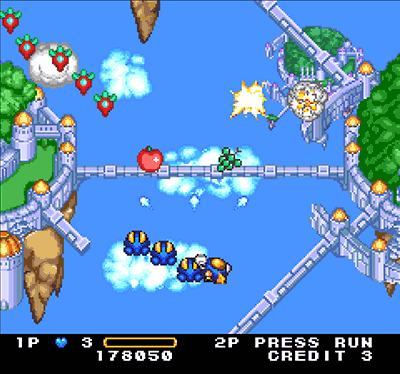 Developer: Konami
Developer: Konami
Publisher: Konami
PC Engine
If you want to see Konami’s work on another cute-em-up, but in a vertical format, Detana!! Twinbee (aka Bells and Whistles in arcades outside of Japan) should be right up your alley. Twinbee is one of the most famous cute-em-up series in Japan, and perhaps the very first of the subgenre. As mentioned above, it also gave some style and gameplay inspirations to one of the other landmark series, Parodius.
The original Twinbee was modeled after Namco’s Xevious, but with a cuter and more playful vibe. Much like Xevious, players can both shoot at airborne enemies and bomb enemies on the ground level below you. Detana!! Twinbee also adds a powerful charge shot to help power through your opponent. In the Twinbee series, you shoot clouds or bomb ground enemies to collect bells for points and power-ups, shooting them to change their colors/upgrade type. This system takes some discipline and patience, however, as it takes multiple shots to get a more desirable item and could be cycled back to the first color or even a bee if shot too many times. In addition to engaging the enemies, balancing the bell harvesting adds an extra layer of skill needed to thrive in the game.
Detana!! Twinbee carries over many of the same powerups from the original Twinbee arcade game (the trailing options, the shield, etc.) and “bell chaining†scoring system. In addition to the five different colors in the original TwinBee, there are two new additional bells in Detana!! Twinbee: a purple bell that provides a “tail shield†that activates multiple barriers around the player’s ship and black bell which decreases the player’s speed. When the Twinbee gets hit, it loses an arm, which prevents you from dropping bombs. You can regain your arms by catching a little ambulance that shows up. Just try to avoid getting hit before recovering your arms.
The two-player co-op mode is a wonderful part of Detana!! Twinbee. While sharing the screen, TwinBee and WinBee can join hands and combined in a powerful fire bullet attack. One player can also push the other ship, resulting in a spread shot. These co-op dynamics create a fulfilling teamwork experience.
The primary upgrade in Detana!! Twinbee over the original is its jolt of personality. Not only have the graphics and sound drastically improved drastically over the original, but the Bees’ pilots and other characters are given a place in the spotlight via brief inter-stage cutscenes and other interludes. Thanks to the creative artistry of Shuzilow.HA , the game’s bright and colorful world finally truly shines through, and as a result this entry still stands as the most popular and defining Twinbee title released to date.
The graphics are brighter and more colorful than the likes of Parodius Da! and happily the levels require you to properly practice and master them to make progress. Rounding our the title is solid layouts, good difficulty curve, great boss fights, and the fascinating power-up system. While the series isn’t as well-known in the West, it’s popular in Japan and for good reason.
Check for Detana!! Twinbee on eBay
Tatsujin/Truxton
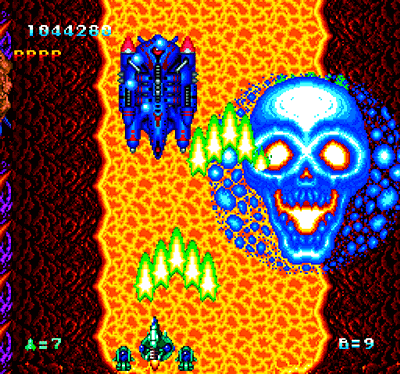 1992
1992
Developer: Toaplan
Publisher: Taito
PC Engine
Tatsujin (known as Truxton in the US) is a solid and notoriously difficult vertical scrolling shmup from genre stalwarts at Toaplan. It was instant classic when it arrived in Japanese arcades in 1988 and has been considered one of the finest “classic†shmups ever since. Four years later, it was finally ported to the PC Engine (three years after the Genesis/Megadrive port).
Instead of focusing on modern features, Tatsujin was developed with great attention to detail and providing a balanced, but tough challenge. Toaplan had spent time refining imperfections in their formula from previous works like Tiger Heli and Kyuukyoku Tiger.
On a basic level the game is not too dissimilar from its predecessors, aside from an even more infamous reputation for merciless difficulty. Tatsujin departs in how much effort is put into making the experience so immediately engaging, on all fronts, that players will keep coming back no matter how much crushing adversity they encounter. The PC Engine port is even more challenging as you are limited to five continues.
While the game initially lulls you into a false sense of security with slow bullets and sparse enemies, you’ll eventually learn why the game is named after the Japanese word for “Expertâ€. Each of the game’s five levels are each like a marathon requiring pattern memorization, efficient attacks, and pure survival. Most of the few checkpoints don’t have upgrades to be found afterwards so you need to be at peak performance to progress. Enemies come at you quick and often in formations. Some of the larger enemies/mini bosses come in packs and take quite a few hits to take down. Level bosses are, of course, huge and menacing. However, sometimes the mini-bosses are tougher simply because they team up on you.
Tatsujin leaves behind the somewhat bland visual elements of Toaplan’s older games in favor of a brighter, bolder brand of spritework which would serve as an emblem for both the company’s mature efforts and its eventual posterity. Stages and enemies are also more varied in nature, with mid- and end-bosses serving as particularly terrifying spectacles for player and arcade passerby alike: even your smart bomb’s explosion, a huge, menacing skull-shaped blast, is something of an icon in its own right.
In addition to the iconic Skull Bomb, Tatsujin offers a few different weapon options along the way. You start with a standard Vulcan gun, but can pick up either the Expert Beam (large green laser blades) or the Thunder Laser (blue lock-on lasers). The Thunder Lasers are especially fascinating as they let you strafe around your opponents while you’re firing on them, creating a much different feel and strategy than is in typical shmups. There are upgrade items to pick up for speed upgrades (S), extra bombs (B), and weapon upgrade pods (P). You need to pick up five of the weapon upgrade pods to level up your weapon once. Each weapon can be leveled up three times. You can resume with up to four P units after dying, but you’ll need to top it off to upgrade again. There’s also some 1UP and 2P icons occasionally floating around for extra lives.
The PC Engine port was pretty solid and holds up well to the Genesis/Megadrive version. It has a more colorful feel and fills the entire screen with gameplay. The PC Engine version is more challenging but has less cheap death due to the “full screen†view. There’s a few other differences that you can find in comparison notes here  and screenshot comparisons here.
Overall, Tatsujin is is a timeless classic that deserves a place in any collection of serious shmup fans. However, it’s high difficulty level should be reserved for those that have built up their experience with many other classics first.
Image Fight
 1990
1990
Developer: Irem
Publisher: Irem
PC Engine
Image Fight was released by Irem just a year after their work on R-Type and one can see some similarities despite the difference in screen orientation. For some reason, Image Fight far less revered in North America than its sibling. Japan appreciated this franchise more, however, as it was clear that Irem became more adept at this kind of shmup as well as the horizontal variety.
Image Fight ditches R-Type’s signature Force Pod in favor of up to three gunpods (which can be either fixed forward or aimable in different directions based on movement, as well as “thrown†at enemies) and your speed can be adjusted on the fly (one of the earliest appearances of this feature). Your power-ups can only defend against one hit before being destroyed. This could be a good thing, as you can’t collect any different weapons until your current upgrade has been shot off of you.
Much like R-Type, the game is slow and methodical and a basic memory-dependent strategy for success is required here and will punish you severely until you get it right. And like Toaplan’s Tatsujin (mentioned above), Image Fight is intricately designed and very rewarding to fully master. The key to the game is learning how to aim your satellite gunpods well and using their multi-directional firing ability to its full capacity.
Image Fight may not have been quite as innovative or distinctive as R-Type in its day. It also may not be the flashiest game from the era, but there is some fine pixel art to be found even by PC Engine standards. The music helps develop the creepy atmosphere, but isn’t as memorable as other some more ambitious shmup soundtracks. Image Fight is still highly influential in the history of the genre — Image Fight was cited as an inspiration for Treasure’s Radiant Silvergun.
The PC Engine port was rather solid, but there’s some items of note. The graphics are similar to the arcade original, though significantly darker. However, changing to a horizontal TV screen the playing field view is cut in half making things feel cramped. There are multiple difficulty levels and rapid fire support in the port as well. The port is vastly superior to the NES version and has advantages over the versions on the Saturn and Playstation (although the Saturn version can be made almost arcade perfect when using TATE mode with a vertical display).
Even though Image Fight has a tough difficulty level, the Turbo CD-exclusive sequel is even more merciless. If you can conquer this bugger in one credit you’ve earned yourself some respect.
Image Fight II: Operation Deepstriker
 1992
1992
Developer: Irem
Publisher: Irem
PC Engine Super CD
Even though the PC Engine was a shmup powerhouse that was fairly successful in Japan, it was still rather surprising to see Irem bring a sequel to Image Fight as a Super CD-exclusive. It seems that Irem built on the core game engine of the original Image Fight PC Engine port. Things play pretty much the same as the original PC game, for better or worse.
The most significant changes are graphical, so Image Fight II ends up seeming more like a graphically-upgraded level pack that a true sequel that would typically include enhancements and gameplay innovations. It also has some anime cutscenes added on, but they don’t really add substantial value.
The graphics in Image Fight II are more vivid than those in the original. However, with a lack of parallax scrolling, its hard to tell the difference between some foreground and background items. This adds to the already steeper difficulty levels and ends up being rather frustrating. All this requires even more concentration and leaning heavily on memorization — more heavily than the likes of R-Type or the original Image Fight. Shmup fans love a challenge if it is balanced, but this “sequel†doesn’t really fit into that category. Because of these factors, it is hard to give Image Fight II a solid recommendation. It should really only be picked up by hardcore fans of Image Fight or those looking to complete their PC Engine shmup collections.
Check for Image Fight II on eBay
Galaga ’88/’90
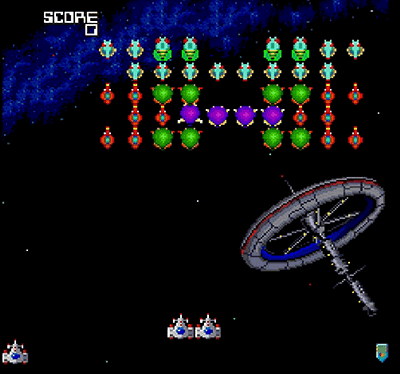 1988/1990
1988/1990
Developer: Namco
Publisher: Namco
PC Engine/TurboGrafx-16
If you’re looking for some more ultra-old-school shooting to round out your shmup library, Galaga ‘88 (released as Galaga ‘90 outside of Japan on the TG16) is a solid title to look into. For those that aren’t especially familiar with the Galaxian/Galaga series, it is Namco’s evolved take on the Space Invaders formula that removes cover and has enemies that could dive at or even capture players. These games are essential cornerstones of the fixed/gallery-style shooter genre.
Galaga ‘88 is formally the third sequel to Galaxian (following Galaga and Gaplus), it features more complex and challenging gameplay and significantly improved graphics over the previous games in the series, including detailed backgrounds, larger enemy design, and greater ship details. Not only do the enemies look better, but there is a more diverse cast and different types of interactions. Some combining into large enemies, a select few have shields, and others exploding into swarms of tiny challengers.
Staying true to an original Galaga gameplay mechanic, Galaga ‘88 features the ability of Galaga Commanders to capture your ship via a tractor beam and the opportunity to double your firepower by successfully destroying the Commander and freeing your captured ship. This time around, you can actually take the risk of getting your double ship for a chance at triple power! The triple ship is pretty large, which increases your hit box drastically, but will definitely help in exterminating the more troublesome foes. You can also collect the occasional red capsule to automatically upgrade you to a triple ship.
It’s impressive enough that Galaga ‘88 features 29 new stages to explore, but the offer more variety above the typical fixed-screen fare. Some levels feature vertical scrolling stages that culminate in a boss battle. Some of the levels also as obstacles such as asteroids and attack satellites that you’ll have to deal with. There are also some bonus stages stages that feature dancing, non-shooting enemies to help you increase your overall score (with a nice bonus for performing a perfect wipeout)
One of the most interesting new features is the ability to warp to different “dimensions†that are alternate level setups that change the enemy designs and attack patterns and increasing the challenge and scoring payoff. Players can warp to these alternate paths by collecting two blue warp capsules before reaching the Bonus challenge stages. There are a total of five different dimensions, each of which have a different final boss to challenge. The dimensional travel adds a lot of depth and replay to Galaga ‘88.
Despite having a somewhat simple appearance and approach, Galaga ‘88 has an interesting risk vs. reward dynamic as you can choose to start with either one or two ships at the cost of a life. This decision also adds some deeper strategic elements as you dive in. Galaga ‘88 is also an easy-to-learn, but tough-to-master classic that is great for score-based players. There’s lots of ways to maximize your scores and the game is actually quite lengthy. The addition of some pretty cool bosses to battle make it feel more at home with more modern Shmups.
Check for Galaga ’88/’90 on eBay
Check for Galaga ’88/’90 on Amazon
Raiden/Super Raiden
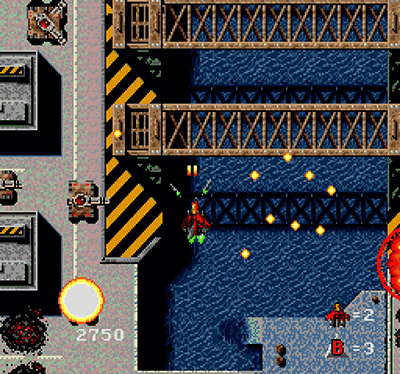 1991/1992
1991/1992
Developer: Seibu Kaihatsu
Publisher: Hudson Soft
TurboGrafx-16 /PC Engine CD
Raiden was a benchmark game for vertical shooters when it arrived in the arcade, a shooter with great pacing, nicely designed weapons, and lots of action. While its pseudo-futuristic military trappings won’t stand out from the crowd much today, that’s largely because this is the title that set in place much of what we now consider “stereotypical†genre features.
Players get two types of weapons and missiles to gradually power up, a bullet-eating bomb, a big hitbox, and yellow enemy bullets to dodge. Scoring doesn’t go much beyond fixed-value medals and shooting things, so anyone in the mood for some old-style blasting (with limited mercy) will be greeted with open arms.
Though the games span locales from countryside to outer space and send all sorts of frustratingly-tough adversaries your way (you’ll curse those sneaky “sniper tanksâ€), you’ll have seen (and been killed by) them all before, and the lot of them are still rendered in the same loving detail as the last time you met.
At a glance it can be tough to spot any particular element which allows such a “typical†shooter to stand out from the rest, but the fact of the matter is that few others can so adeptly bottle the unfiltered appeal of the shmup for mass consumption – near-constant tension, near-impossible odds, huge explosions, no justification needed for any of it.
Most of the other 16-bit versions of Raiden came out disappointing for one reason or another, but on the TurboGrafx and PC Engine CD, we have a very admirable conversion, with good graphics and most of the arcade game’s content (it is, however missing the 2-player option). There’s an improved CD version (Super Raiden and it’s Japan-only) of this game with extra levels and re-done music, so those who have CD models should probably plump for that version.
Check for R-Type on eBay
Check for R-Type on Amazon
Aero Blasters
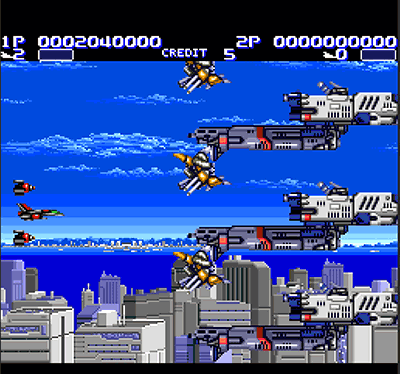 1990
1990
Developer: Seibu Kaihatsu / Inter State
Publisher: Hudson Soft
PC Engine/TurboGrafx-16
This shooter (known as Air Buster in the US arcade scene and on the Sega Genesis) from Kaneko is a solid horizontal shooter that has you flying over ravaged cities, piloting through zero-gravity space, and taking part in high speed chases through tunnels. While it doesn’t at first appear to be an especially innovative shooter, it’s a very well-rounded example of the genre where the power-ups work well and the 2-player is fun.
Players can choose between two ship designs and, with power-ups, can equip them with one of seven sub-weapons. The main cannon can be powered up but not substituted. The charge shot also wipes out basic bullets and single-hit enemies. The sub-weapons include the Side Swiper weapon which adds firepower through vertically aligned options, the Rear Gun which fires two diagonal shots from the rear of the ship, the Six-Way Shooter which fires semi-automatic shots in six directions and the Heli-Pod, which slowly rotates and constantly fires slow, powerful, penetrating bullets with every angle change. Finally, there are two varieties of homing missiles. There is also the Bumper item which protects the front corners of your ship, blocking enemy shots and pushing you away from objects and walls to help prevent collisions during the high-speed tunnel segments of key stages.
The stages are varied, starting in a beautiful metropolis (which you watch get decimated) and ends in a fortress. Aero Blasters features plenty of the dodging and shooting you’d expect, but Kaneko added some variety to keep the player interested. On stage two, the play will be forced to move at full speed through a variety of corridors that take twitch reflexes or memorization to navigate through. Stages three and four change the game physics to mimic zero gravity, and stage six has Ikaruga-like maze elements.
One of the most interesting and least appreciated aspects of the game is the two-player mode. There are two attacks which can only be performed in two-player mode and they are both extremely powerful. The Super Blaster Flash requires both players charge their Blaster Flash and then release at the exact same moment. This powered-up version will deal significant damage and clear even some resilient enemies and objects. The other attack, the Blaster Thunder Attack, requires both players to charge and hold a Blaster Flash and then hit their secondary fire simultaneously. Electricity will arc between both ships and deal massive damage to anything caught between them. Sadly, the timing for these attacks is punishing. Two players must really be in sync with each other to make this work well, but when they are the game becomes a completely different kind of challenge, more about dodging and timing than dodging and blindly shooting.
While it is a competent conversion of a decent shooter, the Sega Genesis ends up with the graphics that are closer to the arcade original. Some have given the TG16 version the edge when it comes to smooth control, resulting in a smoother gameplay experience. Also the TG16 version scrolls and moves notably faster than both the arcade and Sega versions. This ramps up the intensity and makes the cool effects even more convincing. However, both ports still play well and look nice. If you would like to see direct comparison between the PC Engine and Mega Drive versions, check out this great screenshot gallery and this comparison on Sega–16.
Check for Aero Blasters on eBay
Check for Aero Blasters on Amazon
Super Darius, Darius Plus, and Darius Alpha
 1989
1989
Developer: Taito
Publisher: Taito
PC Engine/PC Engine SuperCD
Darius is a series that seems to divide shmup players more than most others. The original Darius suffered from questionable powerup and enemy placement, incredibly strong enemies, and giving players the burden of collecting a ridiculous amount of powerups to gain any actually significant advantage over the enemies.
Darius’s multi-screen arcade unit was something of a gimmick, and much of the game’s design was based around having that landscape view. Shrinking the screen space means some level designs and enemy placements don’t work as well as originally intended, but the funky bosses, the crazy Zuntata soundtrack, and the ability to choose branching stage paths all made it through to the PC-Engine port without a problem. I should note, however, that this game is not just hard but even a little frustrating, although that was also the case in the arcade.
Darius does features a simple but interesting weapon structure. The player’s ship is equipped with two attack weapons: Missile, which is the forward gun, and Bomb, which are the ballistic bombs dropped from the craft. A third capability of the craft is a green energy shield known as the Arm. Players can collect orbs to gradually power up each weapon. If the player powers up a weapon eight times, the weapon changes to a new, more powerful type. When the ship is destroyed, the player keeps the weapon tiers intact, but reset to their lowest levels.
Darius had two releases for the PC Engine system, one HuCard and one CD-ROM. The CD-ROM release, Super Darius, arrived first and featured the full complement of levels but added in bosses from Darius II and featured two original bosses. The arcade original had only eleven unique bosses, but Super Darius has a unique boss for every level. The soundtrack is not remixed, but rather recordings of the arcade soundtrack.
Super Darius was then converted to a Hu Card and released as Darius Plus. Plus has all the same levels, but drops four of the original eleven arcade bosses and adds nine from Darius II for a total of 16 bosses. It features a chiptune soundtrack, of course, and is unique in that it is the only game to be bi-compatible with the SuperGrafx. When played in a SuperGrafx unit slowdown and flicker are reduced. The original Darius release may not be the premier shooter of the PC-Engine, but it’s a solid port of a solid game.
For dedicated collectors, there is also Darius Alpha on the PC Engine that was specially produced as a contest award that featured a straight run-through of only the bosses from Darius Plus. However, there are only 800 copies of Alpha produced, so its going to cost you if you can find a copy.
Super Darius II
 1993
1993
Developer: Taito
Publisher: NEC Avenue
PC-Engine SuperCD
The arcade Darius II continued the original’s tradition of two- and three-screen arcade cabinets with an extended landscape view. It also featured a subwoofer add-on. These features naturally couldn’t be recreated for console home ports. On the Genesis and Master System the game was renamed Sagaia and all the sprites were shrunk down a bit to try to approximate having a wider playfield. The PC Engine approach was quite different.
For the SuperCD, NEC Avenue remixed the game, keeping only three of the original arcade bosses and creating ten new ones. They also used large sprites, constraining the play space greatly. But they also changed enemy patterns and stage layouts to be more compatible with the tighter confines. Bullets are tiny and sprites are huge, but it all works out, as long as you’re OK with things being quite a bit different from the arcade. The end result is quite a bit more colorful and busy than Super Darius. In retrospect, the boss changes from Super Darius really feel like just a trial run for this title.
NEC Avenue also remixed the soundtrack, handing the Zuntata material off to Ts Music: The results are trippy synth rock while Zuntata’s original soundtrack was a crazy, self-indulgent FM-synth trip that vacillated wildly between creepy and psychedelic. The Ts Music interpretation shaves off some of the rough edges of Taito’s FM synth, but in doing so it also loses some of the drug-inspired lunacy.
The level designs are more interesting this time around, but definitely pull inspiration for the likes of the Gradius series. However, the boss designs are quite unique and show some innovation. Darius II also introduced the Captains, which were minibosses that would appear during the middle of the stage. Some of these Captains are smaller version of bosses from the original Darius.
The game adds in multiple difficulty modes to help out those who just can’t handle the punishment the Darius series regularly hands out.
Obtaining weapon power-ups and the upgrade path is completely different from the original Darius: a formation of a specific enemy must be completely destroyed (instead of shooting colored enemies) and every single powerup now grants some kind of upgrade. Further, the various weapons upgrade differently, though the shield upgrade the same as before. Two new power-ups were added: a yellow powerup that adds a new “laser†main weapon that functions somewhat similarly to the bombs, and a rainbow powerup that grants one upgrade to all the players weapons.
The game also adds in multiple difficulty modes to help out those who just can’t handle the punishment the Darius series regularly hands out. Super Darius II ends up being the best quality, most fun, and paradoxically least authentic port of Darius II until the 32-bit generation.
Check for Super Darius II on eBay
Fantastic Night Dreams: Cotton
 1993
1993
Developer: Success
Publisher: Hudson Soft
PC Engine SuperCD / Turbo CD
The first in a series of cute-em-ups from Success, Cotton’s general premise might sound a bit like that of Magical Chase (mentioned in Part 1/Console Exclusives) with it starring a child-like witch riding a broom. Magical Chase is often considered a knock-off of Cotton, but they actually both had their initial release in 1991. Magical Chase received more attention on the TG16 and PC Engine as a whole due to its super colorful presentation,
and high valuation amongst collectors. Cotton also inspired (but feeling less like a knock-off) Keio Flying Squadron on the Sega CD.
Cotton, on the other hand, while still cute and colorful has a bit more traditional sprite design than Magical Chase — though Cotton’s pixel work looks more like they were for a platformer than a typical shmup. However, the dark, dingy environments seem startlingly at odds with the light, silly story.
The game itself is mostly pedestrian, but has some interesting flavor. You’ve got a shot button and a bomb button (just a “regular†ground bomb mind you, not a screen-filling nuke), fairy options, and a limited stock of chargeable magic spells. These spells come in two varieties: the Red Dragon Fire and the Blue Electrobolt.
The most interesting distractions on offer are the Twinbee-esque ability to shoot powerup crystals to change their properties, and the capability to charge up not only your magic shots but your fairy helpers, via the bomb button, to attack directly – in a tight spot you can even let loose both at once for a super ability.
When you die, you suffer experience loss and have to work to get your power back up. To add variety, Cotton doesn’t stick rigidly to horizontal scrolling, and often shifts the play area up or down to keep you on your toes.
The port from the arcade was really solid and many fans actually prefer the TG16 port due to enhanced soundtrack, little bits of invincibility upon casting magic, and extra scoring tweaks.
Forgotten Worlds / Lost Worlds
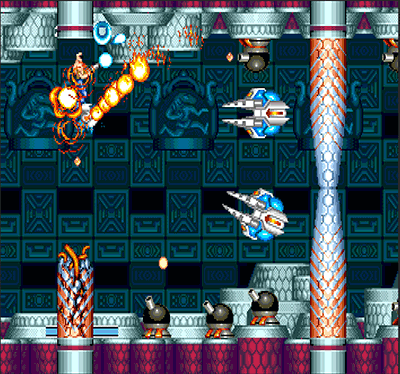 1992
1992
Developer: Capcom
Publisher: NEC Avenue
PC Engine SuperCD/TurboGrafx-16 SuperCD
This arcade classic from Capcom doesn’t follow the traditional shooter formula. Instead of playing as a space ship you are a jetpack warrior that has a small gunner satellite that follows you around. Your gun can be powered up with several upgrades, but you don’t just fire forward in this horizontally scrolling game.
Two of the gamepad buttons will allow the character to rotate themselves in a circular motion thus changing the direction they fire. One button rotates right and the other to the left. The PC Engine’s Avenue Pad 3 controller (Japan exclusive) was actually created to play this game, but a standard controller may be used with some success. The arcade cabinet had a dial to help you rotate your fire, so you can imagine how these controls are downgrade — similar to playing Robotron with an NES controller.
The TurboGrafx-16 port only supports one player, but allows the player to select between either of the two soldiers at the start of the game (with their respective abilities from the arcade version retained). This is a significant disappointment as the arcade (and the Sega Genesis/Megadrive port) was a great co-op title. Upgrades can be bought in shops that appear throughout the levels, though sometimes the game feels a bit cheap as your character is a bit larger than your standard shmup ship, making him an easier target to hit. During the boss battles, this can get frustrating. (removed somewhat iffy “iconic†section)
Forgotten Worlds is still a fun game, though the transition from the arcade’s setup to the PC Engine pad might be too much to overcome for some: if you can get comfortable with the rotating shooting mechanic there is a very enjoyable gaming experience here. The TG16 port did have graphical advantages over the Sega port, partially benefited by the CD format. There is much more detail and larger spites, especially in the bosses; backgrounds and audio are also closer to their arcade origins. The port also retains all of the arcade game’s levels with no cut sections, making for a much longer experience.
Check for Forgotten Worlds on eBay
Check for Forgotten Worlds on Amazon
Side Arms / Super Side Arms
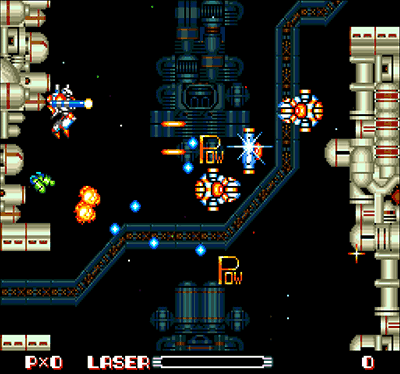 1989
1989
Developer: Capcom
Publisher: NEC Avenue
PC Engine
Hyper Dyne: Side Arms is The only console conversion of this Capcom arcade game (until the Capcom Classics Collections) that was a sequel to Section Z (part of an unofficial Capcom “Jet Pack Trilogy†along with Forgotten Worlds).
The game allows you to control a mobile suit and fire both forwards and backwards (each has a dedicated button), as well as letting you switch between a bunch of different weapons. The player can choose which power-up their “Mobisuit†will receive by shooting the power-up icon until the item they want appears. Mobi-chan, a chibi version of the Mobisuit, is a popular icon in Capcom’s history and has made numerous cameos over the years.
The controls are rather twitchy and unwieldy so Side Arms can be rather challenging. This is even worse with a limit of three credits with no continues. However, Side Arms is more of an “instinct†shooter than one that replies on memory.
Capcom’s work on Forgotten Worlds is more impressive, but the PC Engine version of Side Arms is notable in the way it retains the essentials from the arcade experience including graphics and challenge, sacrificing only the cool two-player mode and requiring you to pause the game to switch weapons. Certain areas, including the soundtrack, are even improved over the arcade release.
There was also an improved port to the PC Engine CD-ROM, under the name Hyper Dyne Side Arms Special that features a new “Before Christ” mode with various changes to gameplay that make it feel more like an R-Type setup, replete with mid-stage reset points, a chargeable beam cannon, support weapons pods, and enhanced graphics. In BC mode the weapon upgrade icons now periodically cycle through the available options while floating through the play field; multiple user-selectable weapons are also eschewed, requiring careful consideration when approaching power-ups.
Both original and BC modes feature tight risk/reward gameplay, placing the upgrade you really, really need for survival in the midst of heavy enemy fire.
Atomic Robo Kid Special
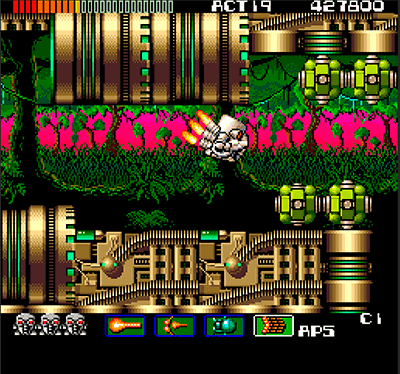 1990
1990
Developer: UPL
Publisher: UPL
PC Engine
Instead of a typical scrolling shmup, Atomic Robo-Kid is what is considered a “push-scroller†or a shmup/platformer hybrid. You can jump with the press of a button, but you aren’t bound to the ground. Instead, you can press up or down to float up or return to the ground. Much of your actions revolve around trying to make your through corridors or cramped areas by blasting baddies and moving methodically. After spending time with fast-paced shmups, Atomic Rabo-Kid can feel rather sluggish, but its a welcome change to the shooting formula.
Atomic Robo-Kid passes through a series of stages to find the exit. Each exit is blocked by a boss enemy, which often needs to be destroyed before the exit becomes accessible. A lot of the enemies won’t kill you when bumping into them, but instead slow you down and get in your way of avoiding harmful enemy fire and progressing through the level.
Atomic Robo-Kid can collect up to four weapon upgrades and switch between them: if they lose a life, they lose the presently equipped upgrade but keep the others. He can also collect powerups for a shield that activates on enemy contact, plus rapid fire and speed powerups. The player can also encounter a friendly dinosaur-looking robot that sells weapons and shields to Robo-kid using extra lives as currency.
The pixel work on Atomic Robo Kid is commendable. Both the large character sprites and the landscapes are quite stunning. The stage design is solid and the bosses are quite large — some taking up several screens. The game will switch up how each stage is presented. Some stages are side-scrollers, while others include a single-screen “duel†with a rival, a maze-like stage that the player explores in various directions and other divergences. Shooting your way through the levels is enjoyable once you get a feel for the levels, but there is a bit of a learning curve.
The TurboGrafx–16 version was called “Atomic Robo-Kid Special†as it was an adaptation of the arcade version, rather than a straight conversion and features remixed levels, removed time limit, plus a power bar instead of death-by-hit. Both the Sega and the TG16 ports replicate the arcade look quite well, but in different ways.
Check for Atomic Robo Kid Special on eBay
Check for Atomic Robo Kid Special on Amazon
1943 Kai
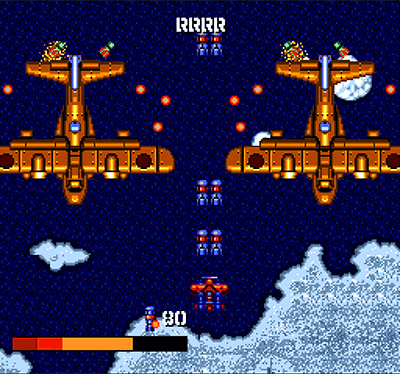 1991
1991
Developer: Capcom
Publisher: Naxat Soft
PC Engine
While not Capcom’s first foray into the genre, 1942 and 1943 are the easiest examples most people still remember, and had enough innovation to spawn a full-fledged series and inspire the likes of Psikyo’s prolific Strikers 1945 series.
While the leadoff title, 1942 kept matters pretty simple (a modest array of enemy types and basic power-ups, plus a limited-use “loop†trick maneuver to escape tight spots), sequel 1943 (and its revision, 1943 Kai) added in, among other things, additional weaponry and a “fuel†meter, which slowly depleted and had to be regularly refilled by item pickups.
Both versions 1943 and Kai include a handful of weapon upgrades such as a 3-way shot, Auto large-caliber machine guns, high-damaging shells, lasers, and Side Fighter options.
Kai is an enhanced, “wild†version that was released in the arcades a year later after the original 1943. Most of the graphics and sounds have been reworked, the weapons have been made more extreme and some fairly strange things (laser-firing WWII planes and ships that run on ground) have been added. The trademark P–38 has been replaced with a biplane, the Boeing-Stearman Model 75.
Naxat ported this classic to the PC Engine and provided five additional levels (but only 8 of the original Kai levels), redrawn and enhanced sprite work and original music. Since the PC Engine version isn’t especially cheap, be aware that the arcade version 1943 Kai was later included in Capcom Classics Collection for PlayStation 2 and Xbox.
1941 Counter Attack
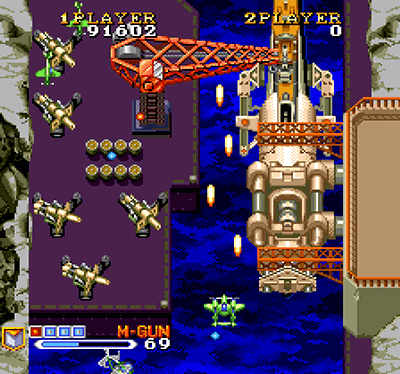 1991
1991
Developer: Capcom
Publisher: Hudson Soft
SuperGrafx
Apparently someone at Capcom realized they’d run out of war years to use for sequels to their classic shmup franchise unless they backed up. 1941: Counter Attack mixes and matches elements from its predecessors and bumps up the presentation another level. The end result is a fast and furious game filled with beautiful WWII-inspired pixel artwork and plenty of firepower filling the screen.
While 1943 Kai originated as a 1987 game running on Capcom’s Commando hardware, 1941 Counter Attack was based on a 1990 release running on a CPS–1 arcade board (same as Street Fighter II). To help capture the full arcade experience, 1941 Counter Attack was treated to a faithful port to the SuperGrafx as the console’s final release. This time the console port was handled by Hudson Soft as opposed to Naxat, noticeably compromising only the sound effects and aspect ratio with a slightly shorter play field. This was also the only console port until some of the Capcom Classics Collections in the mid 2000s.
In addition to some cosmetic upgrades, there are some nice gameplay refinements since we last saw the series in 1943 Kai. There’s some new power-ups including the “After Image†that acts as a quick-following shadow of your ship and fires the standard weapon when you fire. Unlike the options, the After Images stay with you the rest of the level instead of being destructible. Also added to the 1941 Counter Attack weapon lineup is a charge shot that produces different shots depending on your weapon upgrades. Charge shots range from heat-seeking missiles that fly out in a spread pattern to a powerful three-way blast. The fuels system is also replaced by a Vitality meter that starts out at three bars, but can be increased to up to six bars along the way to buffer your hits.
There is far more variety and planning in the level designs. Players experience some canyons and cities, but some of the levels actually take place inside and contain walls. To go along with the enjoyable levels are some incredible bosses that are not only stunning in design, but also show some innovation in attack and evasion patterns.
Check for 1941 Counter Attack on eBay
Twin Cobra / Kyuukyoku Tiger
 1991
1991
Developer: Toaplan / Taito
Publisher: Taito
PC Engine
Much like the iconic 194X series, many gamers might remember Tiger Heli in the arcade or on the NES during their early gaming years. Twin Cobra (Kyuukyoku Tiger in Japan) is actually Tiger Heli’s spiritual successor and is widely considered one of Toaplan’s primary classics. Twin Cobra has you flying over land and sea in an attack helicopter dispatching the enemies and slowly building up a huge arsenal of power-ups.
Compared to Tiger Heli, Twin Cobra tightens things up some, offering more enemy and weapon variety, instant respawn upon death, and a presentational upgrade. One curious design decision was making the bomb slower to activate than in Tiger Heli (but bombs also can’t be destroyed by enemies like in Tiger Heli). You have four primary weapons: a straight shot (that can widen as you power up), a narrow, strong laser, a spread shot, and a forward and sideway shot that becomes cross-shaped when powered up.
The PC Engine version runs the fastest of home versions of the era and plays the most like the arcade version: the game does still show its age in comparison to the later vertical shooters on the system, but that Toaplan playability is there in spades and shines through as always. If you’re looking to play this title on a more modern console, the Playstation has it in its Toaplan Shooting Battle Vol 1.
Check for Kyuukyoku Tiger on eBay
Fantasy Zone
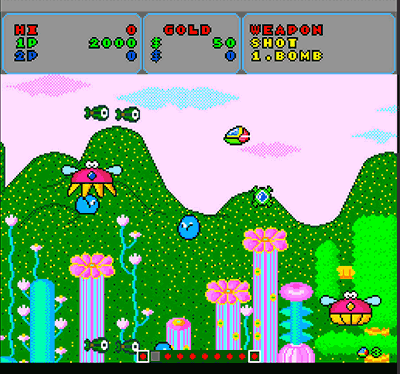 1988
1988
Developer: Sega
Publisher: NEC Avenue
PC Engine / Turbografx-16
This popular Sega arcade shooter was not only popular in the arcades, but was a trademark franchise on the Sega Master System and featured Opa Opa, one of Sega’s early mascots. Even though Sega was heavy into the console wars, it was not afraid to allow certain franchises onto competing consoles and home computers.
Stylistically, Fantasy Zone shares many similarities with the TwinBee series (mentioned above) and is credited with the creation of the “cute-em-up†subgenre. At the same time, Fantasy Zone shares a multi-directional, almost exploratory feel that was pioneered in the arcade classic, Defender. In fact, the level also functions as a vertical cylinder, having you return to the starting point if you fly too far in one direction. In addition to flying in either either left or right, Opa Opa can also walk around the ground. This gives an extra level of variety in how to complete your objective. Even though Fantasy Zone has solid control, it may take some experience to harness Opa Opa’s inertia while maneuvering in flight.
In Fantasy Zone, you can only proceed to the the boss battle when you have hunted down and destroyed all the static “bases†on each level. There is a radar at the bottom of the screen showing which bases are active in the stage. The bosses are each quite large and have their own style and personality. The final stage presents you with a boss rush before the player takes on their final challenger.
Destroying enemies and bosses yields coins which fall and bounce along the ground. Collecting these will allow you to save enough cash to purchase various weapons and upgrades from a floating balloon shop. Some items are temporary upgrades (showing a time limit in a status bar), but certain upgrades such as the Speed-Up upgrades and Twin Missiles are substantial items that are permanent until you die. Much of the initial fun in learning the game has to do with experimenting with the different power-ups you can purchase and deciding when to use the temporary items.
Overall, Fantasy Zone is an addicting diversion for those that want a different take on the shooter genre. The gameplay is well-designed and polished and the colorful presentation is always enjoyable. The PC Engine port also happens to be one of the best versions of the game before the 32-bit era. The port is technically polished, more colorful that its pre–32-bit peers, and features an excellent soundtrack.
Opa Opa can fire a main shot and drops ground bombs.
Check for Fantasy Zone on eBay
Mr. Heli no Daibouken (Battle Chopper)
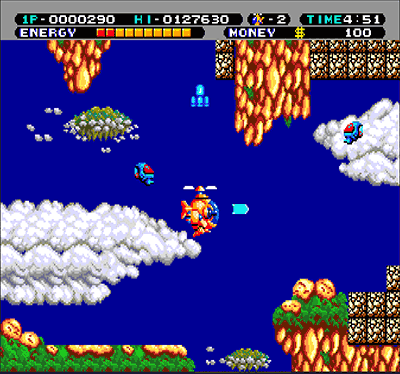 1989
1989
Developer: Irem
Publisher: Irem
PC Engine
While Image Fight was Irem’s first major, traditional shmup released after R-Type, Mr. Heli was a cute-styled multi-directional helicopter shooter that was released just a few months after the Irem’s most iconic production. Instead of a typical scrolling shooter, Mr. Heli (known in North American arcades as Battle Chopper), has a different gameplay setup that feels like a hybrid of Fantasy Zone, Choplifter and a run-n-gun platformer.
Instead of simply shooting enemies, Mr. Heli can destroy parts of the environment with his bombs and missiles to uncover valuable crystals (which can be spent on power-ups) in addition to helping them progress through expansive levels. The available power-ups include an improved gun, missiles, smart-bombs and energy tanks. Some of these items are also hidden amount the blocks as well.
Mr. Heli both fly and walk within the levels and can turn around, but cannot progress backwards through the level. He can shoot right in front of him, turning left or right. As opposed to most helicopter shooters, bombs are deployed while Mr. Heli walks. Instead of dropping straight down, bombs roll across the ground before exploding. The missiles are launched directly upwards with the same button while Mr. Heli is in flight.
There’s an interesting level structure to help add to gameplay variety. After making your way through the standard level section, you will face a mech-style mid-boss, navigate through a dark dungeon area that uses your gun to light the way, and then face the final boss for the level. It’s cool to see Irem try innovative level design in the mid 80’s.
While, Mr. Heli isn’t an intense shooter, it is still a cerebral experience that remains a rather unique experience. It is fun addition to a shooter collection full of surprises.
Check for Mr. Heli no Daibouken on eBay
Ordyne
 1989
1989
Developer: Namco
Publisher: Namco
PC Engine / TurboGrafx-16
While not as big as Pac-Man, Dig Dug, Galaga, or Xevious, Ordyne is another jewel in Namco’s classic arcade crown (enough to show up in a Namco Museum collection) that is especially inviting if you’re a fan of the Fantasy Zone series. Unlike Sega/Sunsoft’s classic, however, whose play style calls Defender to mind, Ordyne is laid out like a more typical side-scroller, with the left-to-right stage/boss progression you’ve come to expect; as you bring down enemies (who exit the stage with a sharp, balloon-like “popâ€) with your trusty forward gun and ground bomb, many will leave behind floating “crystal†items, which you can accumulate and keep a stock of throughout. What’re they used for? That Fantasy Zone influence should quickly assert itself once you enter one of many mid-level shops, and the friendly girl behind the counter is paying off her college tuition loans by the time you’re done browsing.
Most of the available enhancements (such as a Pac-Man-shaped bullet-eater) are temporary in nature, and players normally only get to choose one at a time (which at least prevents them from blowing all their cash at once on bulking up): on the other hand, they can sometimes get lucky at a competing “Dream Co. Ltd.†establishment if they can stop its slot reel precisely for a big payday. Once you’re outfitted it’s just a matter of dispatching the baddies and dodging obstacles en route to the finish line: while Ordyne is neither as challenging nor as immediately distinctive as a Parodius title (no ballerina panda-ducks of doom here), it remains an endearing, cartoon-flavored romp, and its visuals have held up remarkably well from when it first hit arcades in 1988.
Compared to the arcade original, the TG16 port is lacking all of the amazing sprite deformation effects. The breathtaking rotating backgrounds were also replaced with traditional moving sprites. However, the two-player co-op mode still remains as a great feature. This makes it one of the few co-op shmups on the TG16 and it adds a lot of value to the title.
Hellfire S
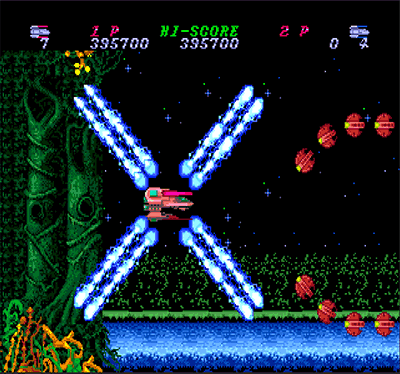 1991
1991
Developer: Toaplan
Publisher: NEC Avenue
PC Engine CD
Hellfire was Toaplan’s first of only two horizontal shooters (Zero Wing, mentioned below being the other), but it still pulled off a solid job showing some interesting innovation. What sets Hellfire apart from many shmups is the shooting mechanic, which allows you to choose one of four directions (forward, backward, vertical, and a four-way x-shaped diagonal) to shoot in with the press of a button, and it works very well. The button cycles though the different weapons in the same order and players will begin to build instinctive switching strategies for the more intricate parts of the levels. This weapon offering is the core with only the occasional weapon power-up icons to be found.
There’s quite a bit of diversity in the themes of the levels. While the levels do often have a bit of an open feel to them, there are a healthy amount of obstacles to maneuver around and keep you on your toes. The slow movement of the level scrolling and your ship movement combined with the thought-intensive, multi-directional weapons system makes Hellfire feel like a very methodical shooter.
The sprite artwork is above average in Hellfire and the game features some subtle but impressive ship animations, both for the players’s ships and the enemies. These subtle rotations and pivots add a nice amount to the visual depth. While the PC Engine version doesn’t have as much parallax scrolling as the arcade version and Sega Genesis/Megadrive port, it does have more crisp-looking spites and a more smooth presentation than the Sega port.
The PC Engine version, contained some other notable differences from the arcade game and the Sega port, including a remixed, more orchestral soundtrack, animated cut scenes, and the replacement of the leading male character Lancer with a female character called Kaoru. If you play the PC Engine port after your Sega version, you’ll also notice that the PC Engine version is notably easier due to increased firepower and instant respawns. The PCE port does have a nice CD-based soundtrack that still feels arcade-like but some might feel more appealing. The PC Engine port also boasts a two-player co-op mode, if that appeals to you. However, the Genesis version with its extra weapon additions, rigid challenge, and parallax scrolling could warrant arguments for it being the superior port. Just keep that in mind when shopping for a copy of Hellfire.
Zero Wing
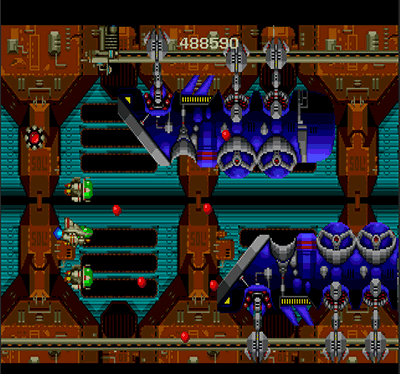 1992
1992
Developer: Toaplan
Publisher: Naxat
PC Engine CD
If you are familiar with the “All Your Base†meme, this game (specifically its Mega Drive port, this one has a completely different opening sequence) is its origin. (Deleted additional references to poor translation) Zero Wing is one of Toaplan’s only side-scrolling shooters, the other being Hellfire, and fortunately there is still a good amount to enjoy in this port even without the meme-worthy intro.
Your ship, known as ZIG, is equipped with two indestructible satellites that hover above and below it, and fire whatever weapon the ship is equipped with at the time. There are three different weapons available in the game and each can have three power levels. These include a red spread, blue laser, and green homing shot. You’ll need to make sure you power them up before you get to later levels or you will be hurting.
There is also a tractor beam that you can use to grab and throw enemy ships. This beam will grab smaller baddies and hold them in front of your ship as a shield. By hitting the button again, you can throw the enemy at other enemies, to do more damage than basic shots. A bomb works similarly, if you have one — hit the button to toss it at the enemies and watch the explosion unfold. The grapple beam is nice, but not as central to the game as the enemy-takeover mechanics in BlaZeon (Arcade/SNES) or Zaxxon’s Motherbase 2000 (Sega 32X).
Graphically this is a fairly nice-looking game and some of the level designs are interesting and creative; the TG16 port is also more colorful than its drab Sega sibling. It does, however, lack some of the parallax scrolling found in the arcade and Sega port, but instead adds a nice scrolling starfield effect that appears on several levels, and there is some use of horizontal-strip parallax as well. Thanks to the CD medium, the soundtrack also exceeds those of the arcade and Genesis/Megadrive. To round out the port, the TG16 version includes a couple of extra levels.
Zero Wing can be challenging and it is a fairly well-rounded, above average shooter once you get to know it.
Check for Zero Wing on eBay
Check for Zero Wing on Amazon
Heavy Unit
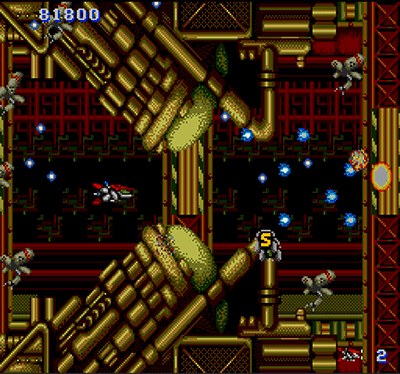 1989
1989
Developer: Kaneko
Publisher: Taito
PC Engine
Heavy Unit is a game by Kaneko, a company with a decent shooter resume including Air Buster, Nexzr (both mentioned above), and Cyvern (Arcade). Unfortunately, Heavy Unit does not quite stack up to the aforementioned games, but it does possess some redeeming characteristics.
You control a ship (with a laser and missiles as auxiliary fire) that has the ability to transform into a mech, similar to a “variable fighter†in Macross by obtaining a Transformer (T) upgrade pod. In this mode, you get a new set of weapons – the laser is replaced by a powerful plasma beam and the missiles by homing balls of energy. The mech setup is more powerful than the ship, but its larger size makes it difficult to use in some situations. You also need another (T) to switch back, as opposed to changing at will. Other upgrade pods include Speed Ups (S), Shield Units, which absorb a few hits (B), Power Boosters (P), and Extra Lives (E).
The levels are distinctive, creative, and meticulously designed. Standard enemies are interesting and have a purpose in placement and design. The bosses are rather large and some of them are pretty strange. Visually, one of Heavy Unit’s weaknesses is the lack of parallax or other wowing visuals. The sound design is rather disappointing and, unfortunately, its shooting sound effect gets annoying fast.
The unbalanced difficulty is also a strong concern with Heavy Unit. Checkpoints are awkwardly placed and you’re left without your upgrades after a death. However, there are a handful of interesting things about the game. It’s worth spending some time on, but not for everyone.
Armed Formation F
 1990
1990
Developer: Majuyudo / Big Don
Pack-In Video
PC Engine
Japanese arcade developer, Nichibutsu is best known for their work on Crazy Climber in addition to the early 80s shooters, Moon Cresta (which was a hack of Galaxian) and Terra Cresta. One of the descendants of Terra Cresta is Armed Formation F, an interesting vertical shmup which gives you floating option pods called Armers that can be maneuvered to fire in front of you, or behind with the touch of a button. This comes into play often as enemies also swarm in from both the top and bottom of the screen.
The biologically-styled levels here feel a bit cramped thanks to many barriers in the margins of the play field. The barrier designs get more expansive and unwieldy as the levels progress, requiring precise flying. The game just loves to put you in tense tight spots. The player’s ship also moves very slow (a constant theme in many Nichibutsu shooters), which can help with navigating the terrain, but becomes very frustrating when dodging incoming fire. There are speed power-ups to be found, but they take some work to hunt down.
In addition to speed boosts, there’s also weapon pickups to be applied to your options along the way. There’s actually quite a diverse lineup of weapons to collect and a different set is available for each of the levels. If you pick up an “F†icon, you can send our your options out further to spread their firepower. This can be used for strategic pre-emptive strikes, but you also sacrifice the protection of them being at your side. There is also some learning involved to master grabbing the best weapon for a particular part of a level.
Even with the context of the original arcade version being released in 1988, Armed Formation F feels more dated that the likes of R-Type (1987) and Truxton (1988). The PC Engine port also wasn’t the best port work on the platform, so its another step down on the visuals and lose much of the interesting detail of the arcade original. The colors are vibrant, but its use of those colors makes it difficult to tell bullets from backgrounds. The core of the game design is interesting and worth a try, but it’s a shame that it didn’t take better use of the PC Engine hardware.
Check for Armed Formation F on eBay
Gokuraku! Chuuka Taisen (Cloud Master)
 1992
1992
Developer: Hot-B
Publisher: Taito
PC Engine
This arcade gem was better known for its Sega Master System port as it actually made it out of Japan (also saw a Famicom port), but this nice PC Engine version could either be looked at a hyped-up re-imagination or a bit of a sequel to the arcade game. You play as a boy that ride on a magic cloud to rescue a princess. For those interested, the premise of the series is actually based on the literary character Sun Wukong, better known as the Monkey King and the secondary character of the Chinese novel Journey to the West.
The boss fights are one of the highlights of Gokuraku! Chuuka Taisen with unique patterns and attacks set in the sky with lots of parallax scrolling to bring depth to the colorful skies. There are also some mid-bosses on each level as well — defeat them and you’ll be able to enter a store to select one of four available secondary weapons. There are also so modest power-ups icons to collect for increased fire power, speed boosts, or brief invincibility. Once you collect some weapons and power-ups, you can progress nicely, but upon dying you’ll be starting at your default configuration.
While the first button on the controller is for shooting, the second button reverses your direction. Much of the level design and boss fights plays off this mechanic, so its worth practicing . It’s not an especially deep gameplay addition, but its nice diversion.
The PC Engine version may not be as colorful and vibrant but it is full of beautiful muted, pastel tones that have their pleasant personality. The pixel art still has a charming cartoon-like appearance and is complemented by nice animation, plus surreal items and opponents that you encounter. The soundtrack is pleasant, but forgettable. However, the sounds effects are rather annoying and generic chirps. You might be better keeping the volume down on this one. However, overall, Gokuraku! Chūka Taisen is a fun shooter with solid gameplay and solid control.
Check for Gokuraku! Chuuka Taisen on eBay
Rabio Lepus Special
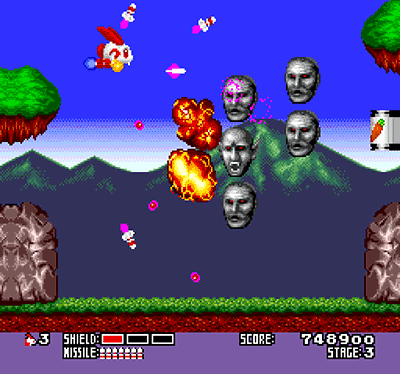 1990
1990
Developer: Video System
Publisher: Video System
PC Engine
Rabio Lepus Special is a remixed home version of Rabio Lepus (known as Rabbit Punch outside of Japan), which is a cute, yet difficult sidescrolling shooter where you play as a Rabbit Mech named Rabio. While not as well known, Rapio Lepus is considered to be the precursor to the Sonic Wings series with its style of gameplay in addition to its cast of characters and bizarre enemies. The game’s designer, Shin Nakamura also went on to create Sonic Wings and then found co-found Psikyo.
The game has a great cute-meets-robo style and has a pretty simple game style, but it is devilishly difficult. It features numerous changes to accommodate the console, including the lack of a two-player mode. Therefore, despite the title, Lepus is not playable as this is a one player affair.
The basic weapon setup is pretty typical: one button for flashing shots and the other launches your limited supply of homing missiles. Your missile supply can be replenished by calling canisters of carrots along the way. Your standard shot can’t be upgraded, but the missiles can be doubled in quantity and strength by collecting a ribbon. To round out the attacks, there’s the risky-but-powerful punch attack that you can pull off when in close range of an enemy. Its one of the few times, and possibly first, a melee attack like this is used in a shmup.
Rabio can take up to three hits before losing a life and can recover these hits by collecting carrots from specific enemies. You can also collect a tanooki to give Rabio a temporary burst of invincibility.
Rabio Lepus Special’s controls are solid, but the game throws a lot at you, resulting in quite a challenge. The game has a lot of charm and would have been cool to see another formal sequel with more refinement.
Check for Rabio Lepus Special on eBay
Daisenpu (Twin Hawk) / Daisenpuu Custom
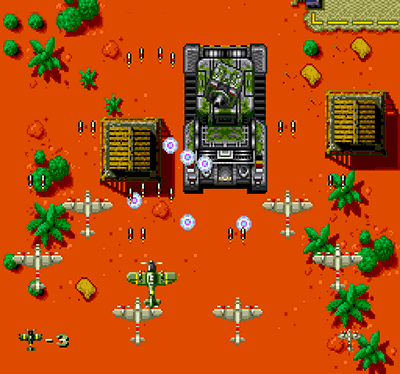 1990 / 1991
1990 / 1991
Developer: Toaplan
Publisher: NEC Avenue
PC Engine / PC Engine CD
Even more Toaplan! If you have played Truxton and/or Fire Shark you will be right at home with this shooter. Twin Hawk is a WWII-themed shmup developed by Toaplan . Like 1942 you play as a warplane that is in charge of decimating waves of enemies. Unlike 1942 all of your foes consist of tanks and boats. This is a unique feature of the game that isn’t a fault, it’s just a bit odd compared to the plethora of other WWII-themed shooter.
However, the main gimmick of Twin Hawk is that, instead of having a bomb or special weapons, you call upon a whole squadron of planes to fly with you and shoot at whatever is in front of them. They are pretty weak overall but it is an interesting way to do a special attack. Your squadron will follow your lead in firing and moves to the left and right, but otherwise stay behind in formation.
One of the more interesting aspects of managing the squadron is that if one member of your squad gets shot down, they will do their best to take out enemies as they do down as the rest of your squad keeps chugging along. However if your main craft goes down, the rest of your squad will join you in a suicide attack.
Other “bomb†attack options include sending all the surviving planes in for kamikaze attack or doing more of a smart bomb effect immediately after summoning your squad. There are a few power-ups and items randomly hidden for firepower upgrades, 1UPs, and additional squadrons.
There are actually two different version of Daisenpu/Twin Hawk for the PC Engine. The HuCard version is actually considered superior as the changes made CD version’s soundtrack, backgrounds and animations aren’t very complementary. It also has a puzzling choice to split the game into different stages, breaking the continuous flow of the original. There are completely different bosses, however, if you want to explore both versions. Compared to the Sega Megadrive version, its a respectable port, but fills the whole screen with visual as opposed to the Megadrive reserving the right side for a status bar.
At its core, Twin Hawk’s setup can seem minimalistic, but it does show some innovation and gives shmup fans a different take on the genre. The game is not exceptional, but a good title to round out a collection.
Dragon Spirit
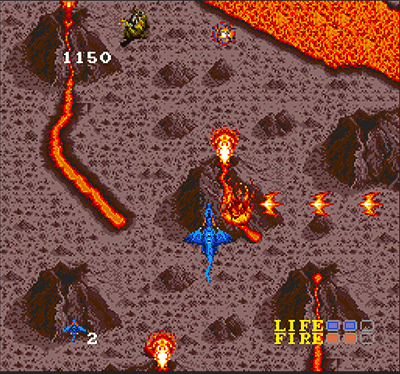 1998
1998
Developer: Namco
Publisher: Namco / NEC
PC-Engine / TurboGrafx-16
Dragon Spirit was a Namco shooter which hit the arcades in 1987. It was ported to the PC Engine a year later, and to the Famicom a year after that. The game takes the core mechanics of Xevious and bolts them to a fantastical setting where the player transforms into a dragon to rescue a princess. There are a handful of lengthy stages to battle through in this tough journey. It remains as an underground classic, with more notoriety in Japan. It’s a great theme on a solid game engine.
The basic gameplay elements are similar to Xevious, in that you have a standard weapon that can hit aerial targets and a bomb you can use to hit targets on the ground below your dragon. The powerup system gives you a few cool options. One kind of powerup gives you an extra head, up to three heads, allowing you to dish out up to three times the shots and bombs. You can pair this with a fire breath powerup that allows you to sear the screen with three long gouts of flame. There is a down side, however, in that a three-headed dragon has a large hitbox, making you an easy target. There are other power ups that give you various other attack types, but those replace the multiple heads power up. One even shrinks your dragon down, reducing firepower but making it much easier to dodge enemy fire. You can also earn an extra dragon by collecting three special egg power ups.
The PC Engine port changes some of the level content starting at level 6 and reduces the number of enemies and intensity of enemy fire a bit, but expands the hitbox a bit. This means that the game is still punishingly hard, but not quite as deadly as the arcade. The graphics and the soundtrack ported over fairly authentically from the arcade and hold up well. The soundtrack is good enough to go into regular chiptune listening rotation.
Check for Dragon Spirit on eBay
Dragon Saber
 1991
1991
Developer: Namco
Publisher: Namco
PC Engine
Dragon Saber is the refined sequel to Dragon Spirit, and the PC Engine is the only console that received a port, save an appearance of the arcade version on Namco Museum Encore for the Playstation. It hit the arcades in late 1990 and turned up on the PC Engine a year later. Despite improving on its predecessor in nearly ever way, Dragon Saber clearly didn’t get much love compared to Dragon Spirit, which had ports on a variety of consoles and Japanese PCs. And that’s a real shame, because Dragon Saber is everything Dragon Spirit was but jacked up to 11.
The arcade version features a number of fantastic special effects, better graphics, and a soundtrack that is fantastical and prog-a-licious. The PC Engine port is naturally compromised a bit in this regard, but it still holds up very well. It plays, looks, and sounds better than Dragon Spirit, but is otherwise a very similar game, and that’s not a bad thing.
Your main shot hits things in the air and your bomb hits targets on the ground. It’s easier to power up your main fire breath now that you only need one orb instead of three. Collecting red orbs boosts your dragon’s firepower while blue orbs increase your base damage capabilities.
You can still grow multiple heads for more firepower. However, there are some additional weapon powers as well that replace the multiple heads and expand on the selection from the original and each feature a unique super attack. Your shot now charges automatically when not being fired. You can also hold down the fire button to have your dragons launch flames continuously. T To round out the gameplay refinement, hit detection has also been cleaned up a bit.
There is also a two-player co-op mode as well that is loads of fun. You can work together to do your charge shots and continuous flames for lots of firepower.
If you like Dragon Spirit, you’ll greatly enjoy this follow-up, especially the soundtrack. The PC Engine version has a very different sound capability than the arcade board but the soundtrack is still fantastic.
Check for Dragon Saber on eBay
Xevious Fadraut Densetsu
 1990
1990
Developer: Namco / Compile
Publisher: Namco
PC Engine
Namco’s classic Xevious has mostly remained in the public eye due to Namco museum complications, but this influential classic otherwise doesn’t have the same longevity of the likes of R-Type and Gradius. However, Xevious’ creation is the point where the shmup as we know it began to emerge in earnest: detailed, scrolling backgrounds split up into recognizably separate levels, a “dual-plane†setup which differentiates between ground- and air-based targets, enemy AI which keeps track of and exploits the player’s inherent weaknesses, end-level bosses with “core†weak points to attack. Hmm, any of that sound familiar? You can thank Xevious (and sole creator Masanobu Endo, whose numerous other credits include Grobda and Tower of Druaga) for bringing it all together in such fine fashion.
The original game, after all these years, remains the best-known of the lot. As with the Space Invaders games, most of its sequels play pretty similarly. Seeing as the Xevious series has become synonymous with “the shooter boiled down to its essentialsâ€, you can’t blame Namco too much for stepping back and letting it do what it does best. The little gray “Solvalou†player ship, unassuming as ever, returned in a number of follow-ups including a title on the MSX computer system developed by shmup masters, Compile, named Xevious Fadraut Densetsu.
This title featured a couple modes: one that is essentially a port of the arcade and the other that has new levels, multiple ships, and new enemies and boss battles. The PC Engine version is actually intended to be a bit of a follow-up to the MSX game even though it shares the same name. The PC Engine still has the Arcade mode for the best pre-Playstation console ports of the classic, but the “Fardraut” mode is a 4-stage story-based mission with new enemies and piloting a different ship on each level. At the end of each level, a boss battle which is similar to one of the MSX bosses will be at the end of each level. This is slimmed down from the ambitious 16 stages with different bosses in the MSX version, but is more challenging and a nice addition to the arcade mode.
Overall, this is a great port and expansion of an arcade classics. However, the appeal of this might be limited to fans of the arcade game or those that really want to explore the roots of the genre. Currently, the game sells for relatively reasonable prices, so it may be a solid way to round out our collection.
Check for Xevious Fadraut Densetsu on eBay
P–47 – The Freedom Fighter
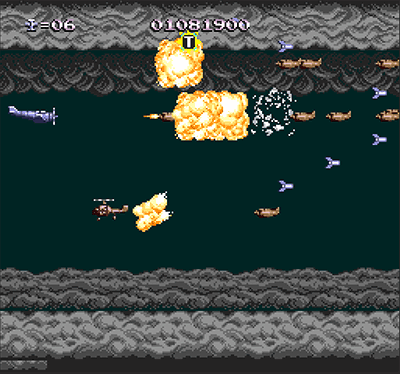 1989
1989
Developer: Nihon Aicom Kaihatsu
Publisher: Jaleco
PC Engine
In 1988 Jaleco released a horizontal shooter to compete against Capcom’s ‘19XX’ series in the arcades. Rather than using the infamous P–38 Lightning, this game’s aircraft of choice is the tank-of-an-airplane P–47 Thunderbolt. While the developer took some liberties with the designs of the enemies, players can expect nothing but typical World War II battle machines. There are some levels in the game which are very similar in design to stages in the SNES classic, U.N. Squadron. In any case it’s great to play a shoot-em-up that is not set in space or a different planet.
There is a fairly simple power-up system. Power-up icons either come by way of helicopter or hidden in the sky. There are certain ‘sweet spots’ in specific areas of the sky which hide icons. The power-ups range from missiles, bombs, multi-directional turrets, and some strange exploding mechanism. Other than power-ups you can find icons for speed, 1-ups, and continues. You are only given two continues, so that “C†icon is very precious. After playing the game a couple times you’ll learn which weapons work best with each level. Some levels require you to change your weapon strategy and the game helps you along by giving you a hint (the same icon appearing numerous times in a specific area) of which power up would work best at your current location.
P–47 starts fairly easy but punishes you if you become complacent. Enemy bullets blend into the background on level two which can cause some frustrating deaths. Graphics could have been just a bit more colorful like the arcade version. The drab colors do make the game somewhat depressing to play.
The difficulty level on later stages provide a great challenge. A fair variety of enemies for an 80’s shooter. There are points in the game that are absolutely manic and those who have been trained in modern bullet hell shooters would appreciate them. For example, level four features a large battleship full of turrets and deadly cannons. Plenty of power ups and requiring a basic strategy of when to have what adds some depth to the game.
Check for P–47 – The Freedom Fighter on eBay
Tenseiryuu / Saint Dragon
 1990
1990
Developer: NMK
Publisher: Aicom
PC Engine
This interesting shmup gives you control of a cyborg dragon that is initially armed with plasma bolts and fire breath while also having the ability to use your tail to deflect bullets and harm enemies. The head of your mechanical creature is its only vulnerable section and the flight patterns of the dragon’s tail is quite interesting. The bigger aliens and the end of level guardians will require some skillful flying as well as a lot of firepower to destroy.
By collecting tokens, the dragon’s firepower can be upgraded with pulse torpedoes, a laser, bouncing bombs, ring lasers or a turret. Other tokens can upgrade the dragon’s speed, weapon power, or initiate a “hyper†mode which endows maximum firepower and invulnerability.
Many of the level designs feel like something out of Terminator’s future mixed with fantasy elements. Your often battling other cyborg beasts of various sizes and attacks. Some of the later levels are a bit less interesting portraying a more basic space environment.
Overall, Saint Dragon is a very solid concept with some interesting innovation, but the novelties wear off after a few levels as there isn’t enough variety and substance through the game to make it feel like its worth investing time. The PC Engine port is pretty solid compared to its source material, however, including many of the large enemies and bosses. Saint Dragon saw a number of personal computer ports, but the PC Engine was the only home console port.
Check for Saint Dragon on eBay
Additional TG16/PC Engine Games for Shooter Fans
While they don’t fit the typical shmup definition, I wanted to make note of some additional games that are worth keeping in mind. Sega had a few pseudo–3D third-person shooters and there were also a couple Space Invaders titles worth looking into.
- After Burner – The furious arcade experience has been replicated very faithfully given the limitations of the PC Engine. It even has some points over the Sega Genesis/Mega Drive version, such as the graded horizon and scaling of the refueling plane. (eBay)
- Space Harrier – Although the graphics are generally a little smaller than the arcade and a tad messy, the scaling is far better than expected for a HuCard. The iconic checkerboard floor from the arcade is missing, but is replaced by a far less interesting striped and color-cycled ground pattern. (eBay)
- Space Fantasy Zone – This one isn’t actually an arcade port, but instead is more like Space Harrier meets Fantasy Zone. This one never actually saw an official release, but has been leaked online. (eBay)
- Space Invaders – Fukkatsu No Hi (Day of Resurrection): this is a PC Engine exclusive variant of Taito’s classic. As well as including an “original modeâ€, which plays identically to the original Arcade version and includes a hidden setting that plays the game in black and white monochrome, Fukkatsu no Hi also includes a “Space Invaders Plus†mode which includes more contemporary 16-bit graphics and power-ups earned from destroying UFOs. (eBay)
- Space Invaders – The Original Game – Another version featuring authentic replications of the original arcade cabinets, along with multi player modes with cute backdrops. (eBay)
Don’t Forget Part 1
If you haven’t seen it yet, be sure to check out Part 1 of this guide that details all the shmups that did not originate in the arcade (most of which were exclusive to the PC Engine/TG16)
Additional Credits: Thank to shmups.com, PC Engine Bible, VideoGameDen, 1CC Log, and Hardcore Gaming 101 for helping me to fill in some of the gaps in our knowledge of the PC Engine’s shmup collection in addition to providing some of the screenshots.
Shmups 101 | Beginner Shmups | Defining Shmups | Hidden Gem Shmups
Shmup Libraries: TG16/PC Engine |Â Genesis/Megadrive | SNES |Â PS1 | Saturn | Dreamcast | PS2 | GCN | GBA

Photo courtesy of @Supersparkster on Instagram
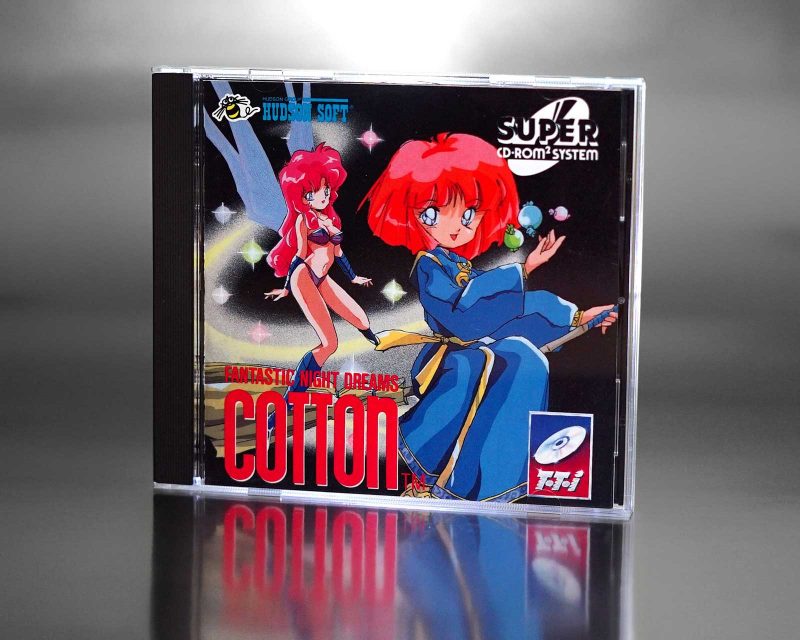
Photo courtesy of @Supersparkster on Instagram
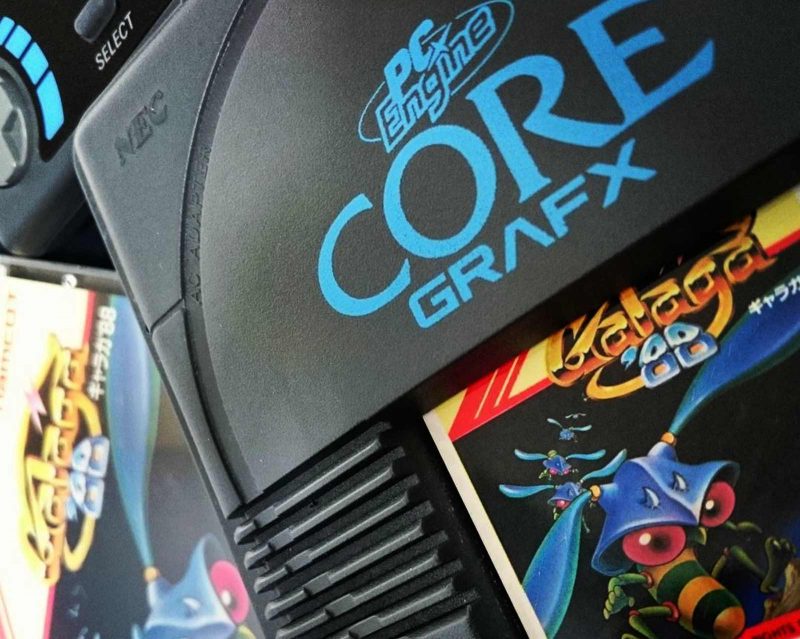
Photo courtesy of @rlock999 on Instagram
Affiliate programs and affiliations include, but are not limited to, the eBay Partner Network or Amazon Associates.
Is the PCE version of Dragon Saber easier?
Thanks for a great list/article, these games sure bring back memories. That reminds me, I need to hook up my old Turbo Duo for a few rounds of Castlevania Rondo. Thumbs up.